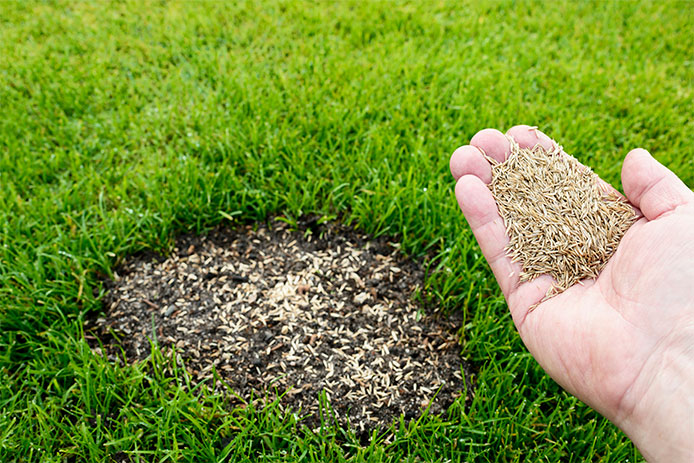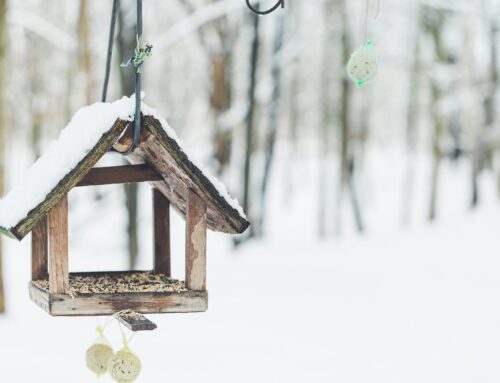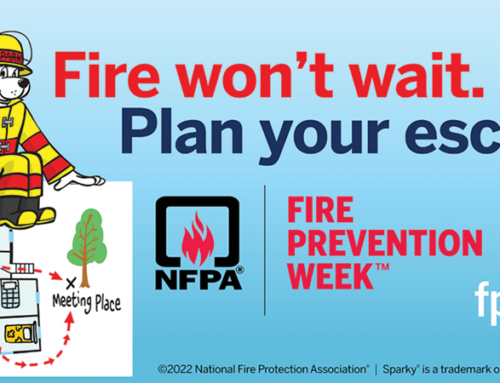Fall Lawn Care – How to DIY

While many homeowners think of spring as the best time to fertilize, feed, and take care of their lawn, did you know that proper fall lawn care is the most important step to a healthy, year-round lawn? If you haven’t fertilized regularly during the summer – and let’s be honest, despite our great intentions in spring, we’ve probably missed a couple of feedings – your lawn is likely starved and/or thirsty from the higher temperatures and lower rainfall levels from the summer, and it needs strengthened before the harsh winter months hit. The key to fall lawn care is overseeding, which consists of aerating, seeding, and fertilizing your lawn.
What is overseeding?

Overseeding is the process of planting grass seed on top of your existing lawn without tearing up the grass or soil. Overseeding helps fill in bare patches in your lawn and makes your lawn more dense. The process makes your lawn stronger and healthier, so it’s best to overseed your entire lawn rather than just filling in the bare patches. It also chokes out weeds and helps your lawn resist extremes in temperature and weather.
Why should you overseed in the fall?

- Rain and soil moistures are often better in autumn
- Soil temperatures are warm in the fall, while the air temperature cools and encourages grass growth
- It helps get rid of summer weeds like crabgrass
- Strengthens your lawn before winter, which can be harsh on many grasses
- It gives your lawn a head start for next spring
How do you overseed a lawn?

1. Mow and rake your lawn
Cut your grass on a low setting and rake up all the grass clippings once you’re done. This is done so that seeds can contact the soil easier and so that sunlight and water can reach the new seeds.

2. Aerate the soil
Aeration allows moisture, air, and nutrients to reach deep down to the roots of your grass to boost the overall growth and health of your lawn. The process requires renting a lawn aerator, a self-propelled, walk-behind machine that you push back and forth across your lawn. The aerator punches small holes in your lawn and pulls out plugs of soil, leaving behind pockets where grass seed, water, and nutrients can collect at the base of your lawn’s roots. For more details Read How to Aerate Your Lawn

3. Spread grass seed
Once you’ve aerated, it’s time to spread grass seed and let it collect in the holes created by the aerator. Make sure you use a fall grass seed and for the type of grass you have in your region of the country. If you have a smaller yard, a handheld spreader will do the trick but many people prefer a walk-behind broadcast spreader for average-sized yards.

4. Fertilize
Adding fertilizer to your recently-aerated and seeded lawn helps boost grass growth and provides additional nutrients like nitrogen and phosphorus. Many professionals recommend avoiding weed & feed formulas; the pre-emergent herbicides can limit seed germination.

5. Add water
Water is essential for any lawn, but recently seeded lawns need consistent moisture for the next 5-10 days. You can water lightly for the first few days after seeding, but after about four days begin alternating between light watering and heavy soaking of the lawn.
Fall Lawn Care Schedule
No matter where you are in the country, you can follow these general guidelines for your fall lawn care schedule.

Early Fall
As summer begins to fade and overnight temperatures start to cool down, you’ll want to begin to address bare or thin spots in your yard. By loosening the soil in these spots and adding grass seed and fall fertilizer, you can help repair your lawn exactly where its needed.

Mid-Fall
Mid-fall is the perfect time to start the overseeding process that we’ve outlined above. The cooler temperatures boost fall grass growth, so you’ll want to aerate, seed, and fertilize to get the most out of the last good growing season of the year!

Late Fall
As temperatures drop, you’ll see more and more leaves start to fall. Make sure to rake and bag leaves quickly, as debris on your lawn can prevent moisture and sunlight from reaching your grass and its roots. A mulching mower or handheld blower are great tools to have for this process!
Properly overseeding your lawn this fall may be the difference between a healthy lawn that comes right back to life in the spring and one that requires a lot of work to get back into shape once winter is over. By mowing, aerating, seeding, fertilizing, and watering at the proper time this fall, you can ensure that your lawn remains healthy all year long.





